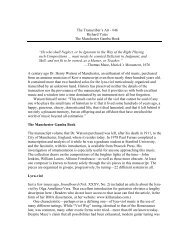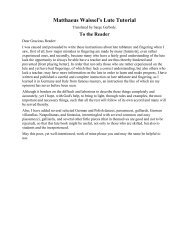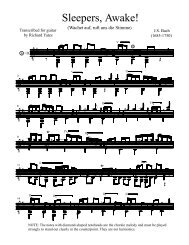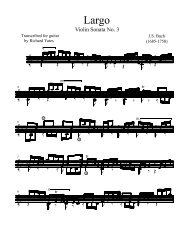The Transcribers Art5.indd - Richard Yates Classical Guitar ...
The Transcribers Art5.indd - Richard Yates Classical Guitar ...
The Transcribers Art5.indd - Richard Yates Classical Guitar ...
You also want an ePaper? Increase the reach of your titles
YUMPU automatically turns print PDFs into web optimized ePapers that Google loves.
Sonata, K. 322<br />
Domenico Scarlatti<br />
Diffi cult do you call it, Sir? I wish it were impossible! —Samuel Johnson<br />
<strong>The</strong> transcriber looking through keyboard<br />
music for suitable material must constantly<br />
ask herself a simple question: Is it even possible<br />
to play this on the guitar? <strong>The</strong>re can be a wide<br />
range of transcribers’ willingness to modify the<br />
original music, but all too often we are simply<br />
confronted with the limitations of the guitar<br />
as compared with a keyboard instrument. An<br />
objective assessment of these limitations, while<br />
dismaying, is also necessary in producing useful<br />
musical transcriptions. So how does the guitar<br />
measure up as a solo instrument? Well, its<br />
pitch range is rather narrow. Its dynamic range<br />
is weak. It can only produce four notes simultaneously<br />
and has relatively modest contrapuntal<br />
agility. <strong>The</strong>re are innumerable combinations of<br />
notes that cannot be played because they are either<br />
too close together or too far apart, or both.<br />
It cannot sustain notes and so can only suggest<br />
connected melody. Its variety of timbres is less<br />
than the organ or voice. And, a few superhuman<br />
players aside, for most of us mortals the<br />
guitar can produce notes at only relatively slow<br />
tempos. Any one of these limits may eliminate<br />
a keyboard piece from serious consideration<br />
for transcription to the guitar, but the last one,<br />
tempo, is the focus of this article. Transcription<br />
inevitably involves modification. <strong>The</strong> question I<br />
will explore is: How is the tempo of a piece affected<br />
by transcription to the guitar?<br />
Tempo and Performance<br />
<strong>The</strong> selection of the tempo of a piece of music<br />
is hardly a trivial matter, even when the music<br />
is played on the instrument for which it was<br />
originally written. It is particularly a problem<br />
with music written between 1600 and 1817. Before<br />
this span there was a theoretically reliable<br />
correlation between time signature and tempo.<br />
All tempos were numerically related to a basic,<br />
presumably universal, beat—the tactus—which<br />
was about 60 to 70 beats per minute. This mensural<br />
notation allows us to establish the tempos<br />
of modern performances with a high degree of<br />
confidence.<br />
In 1817 Beethoven was the first well-known<br />
composer to use a recent invention, the metronome,<br />
to establish tempos for his music. From<br />
this time on, a composer’s intentions about<br />
tempo could be accurately communicated to the<br />
performer. It turned out, however, that even this<br />
did not solve the problems. Beethoven himself is<br />
said to have radically changed his own previous<br />
metronome markings and he once wrote that<br />
the metronome was “of no value.”<br />
Many guitar transcriptions are from the period<br />
with the least agreement about tempo, that<br />
is, the Baroque and <strong>Classical</strong> periods. After<br />
1600 tempo words were increasingly used, while<br />
mensural notation declined. Tempo words carried<br />
little precision, however. Each theorist of<br />
this era seems to have had his own table of tempo<br />
words. Not only do these tables contradict<br />
each other as to what speeds to attach to particular<br />
words, sometimes they even disagree as to<br />
the order of quickness, that is, whether allegro is<br />
faster or slower than allegretto, etc. Compounding<br />
the problem were the overlapping definitions<br />
of tempo words. Some were descriptions of<br />
26
moods, as in allegro (cheerful). Others described<br />
speed, as in lento (slow). Over time some mood<br />
words came to have speed meanings, but others<br />
did not. <strong>The</strong> result is considerable uncertainty.<br />
Underlying most of the debates about tempos<br />
was another concept that was thought to bring<br />
some coherence to it all—the tempo giusto—<br />
but even this term brings confusion in that it is<br />
sometimes used to mean “strict tempo.” It is the<br />
other meaning to which I refer: Tempo giusto<br />
means the “right tempo.” <strong>The</strong> idea was that each<br />
piece of music has an implicit and discoverable<br />
correct tempo. Leopold Mozart said that inferring<br />
the correct tempo from the score “infallibly<br />
shows the true quality of a musician.” <strong>The</strong><br />
implication was that the tempo words could get<br />
you to the right neighborhood and then your refined<br />
sense of the tempo giusto could take over<br />
for the fine tuning, so to speak.<br />
I will show you some hard evidence that bears<br />
on this question a little further on, but we must<br />
first recognize that the foregoing has shed little<br />
light on the central question about tempo and<br />
transcription. <strong>The</strong> question might be reworded<br />
at this point: Does the tempo giusto of a piece<br />
of music change when it is played on a different<br />
instrument? In fact, I have found in music<br />
literature no direct reference to this issue at all.<br />
<strong>The</strong> only remaining avenues for investigation<br />
are unfettered, but informed, speculation and<br />
observation of the actual performance practice<br />
of the best players.<br />
Tempo and Transcription<br />
<strong>The</strong>re are several qualities of the guitar itself that<br />
may affect tempos. Certainly, as an instrument<br />
that cannot sustain tones, the guitar has definite<br />
lower limits of reasonable tempo in slow pieces.<br />
Bowed string instruments, organ or voice can<br />
shape a coherent line using tempos that would<br />
completely fragment the melody on the guitar,<br />
or the piano. Although—as Ralph Kirkpatrick<br />
wrote about nonsustaining instruments, “It is<br />
not sound but mental expectation that produces<br />
musical continuity”—there are still real, practical<br />
limits to this principle.<br />
What of the other end of the spectrum? It<br />
seems that there are reasons for a lower tempo<br />
giusto on the guitar. First, there is the often<br />
overlooked fact that the guitar is a low pitched<br />
instrument. Since guitar music is usually written<br />
with an octave transposition—or with a small<br />
“8” at the bottom of the clef—it is easy to forget<br />
that the E on the first string twelfth fret is only<br />
the top space on a regular treble staff, and the<br />
open sixth string is below the bottom of a staff<br />
with a bass clef. <strong>The</strong> overall pitch of an instrument<br />
has implications for tempo. Lower pitches<br />
are slower to speak. Larger forces and movements<br />
are required to set the string in motion,<br />
and the acoustic events that follow the plucking<br />
of the string take longer to play out. As a result,<br />
rapid notes have less clarity than they would if<br />
higher pitched. In addition, the guitar’s shorter<br />
string lengths, compared to, say, the harpsichord,<br />
mean lower tensions and less clarity.<br />
A more subtle point relates to difficulty.<br />
Technically, the guitar presents monumental<br />
obstacles to speed compared to a keyboard instrument.<br />
Each note played on the guitar usually<br />
requires two fingers. Successive notes require<br />
extremely precise coordination of fingers<br />
on both hands. <strong>The</strong> point is not just that a guitar<br />
cannot be played as fast as a keyboard, it is<br />
that the perceived difficulty, including speed<br />
and complexity, is part of the total experience<br />
of the listener. To quote Kirkpatrick again, “Perhaps<br />
the very opposition with which the artist<br />
is confronted by the tools and materials of his<br />
medium is a stimulant necessary in some measure<br />
to the intensity and concentration of his<br />
communication through domination of that<br />
medium.” Most guitar music played on the piano<br />
sounds thin—it presents little opposition, in<br />
Kirkpatrick’s words—and it is natural (“giusto”)<br />
to play it faster. Conversely, the guitar gives us<br />
more opposition, and hence, slower tempos may<br />
fit better.<br />
Earlier in this article I made unflattering com-<br />
27
parisons of the guitar’s capabilities, and of course<br />
only told half the story. While on each of the dimensions<br />
I listed (pitch range, dynamics, complexity,<br />
etc.) the guitar is far surpassed by other<br />
instruments, it may be that no other instrument<br />
has as great a variety of these dimensions within<br />
which one can create artistic nuances. It may<br />
be the most versatile of instruments, in that it<br />
can produce distinctions in more ways. <strong>The</strong> violin<br />
is sadly lacking in contrapuntal ability, the<br />
harpsichord cannot vary loudness at all, and the<br />
piano always has the same timbre. <strong>The</strong> guitar<br />
can do these things and more, simultaneously.<br />
Well played guitar music presents the listener<br />
with a wealth of subtle variations and nuances<br />
of sound. This is a lot of information to process.<br />
Perhaps the tempo giusto depends on the rate of<br />
information. If this is so, then slower tempos are<br />
necessary in performing guitar transcriptions.<br />
Of course, this assumes that the player is doing<br />
something artistic with all of the instrument’s<br />
potential. Sadly, we have all heard fast players<br />
that were giving us only rapid notes. <strong>The</strong> British<br />
guitarist Stephen Kenyon wrote on this point,<br />
“We are used to hearing a certain amount of<br />
information—hopefully what the player intended—and<br />
if they play too fast sometimes we do<br />
not recognize that and then subconsciously we<br />
think ‘this player’s boring.’ This certainly happens<br />
with some very fast players I can think of.<br />
<strong>The</strong>y proudly play perhaps Bach or Paganini at<br />
exactly the tempi of the fiddlers, but after the<br />
gasps of astonishment have subsided—assuming<br />
they do—they are often, I find, boring.”<br />
Sources of Information<br />
<strong>The</strong> foregoing discussion is mostly speculation.<br />
I felt a need to find some hard data in hopes<br />
that it would provide a firmer foundation to<br />
my theorizing. Leopold Mozart’s advice seemed<br />
a logical way to pursue the question. I decided<br />
to find as many examples as I could of music<br />
played on both the guitar and keyboard to see<br />
how tempos varied with the instrument and the<br />
performer. To cut down the size of the search I<br />
focused on two composers: Domenico Scarlatti<br />
and Enrique Granados. Both composers wrote<br />
keyboard music that has been transcribed and<br />
recorded many times, and so provided lots of<br />
data points from which to observe patterns and<br />
draw conclusions. I later narrowed the search<br />
further when I found out which particular<br />
pieces had been recorded the most. While there<br />
were a few recordings in my own collection and<br />
at the local library that I could actually listen to<br />
and measure with the infamous metronome, I<br />
needed more information. How I obtained this<br />
was a fascinating experience that I hope will be<br />
a useful digression for readers. Those of you who<br />
are already connected to the Internet may find<br />
a few new resources mentioned here; those who<br />
have yet to connect may find that there are good<br />
reasons to do so.<br />
Without access to many actual recordings, I<br />
resorted to the next best source of information<br />
about tempo—the timings that were listed for<br />
the music. <strong>The</strong> samples that I could listen to<br />
confirmed that the overall timings of pieces gave<br />
a reliable measure for comparing average tempo.<br />
<strong>The</strong> advantage of using this measure was that it<br />
gave me access to many recordings through library<br />
catalogs and other people’s collections. In<br />
fact, all the data that I will describe was collected<br />
from my home computer. I have listed some<br />
sites at the end of this article.<br />
On the Internet I was able to get into the<br />
online catalog for a network of 13 college and<br />
university libraries in Oregon and Washington<br />
(ORBIS). In one afternoon I also accessed the<br />
entire University of California catalog (MEL-<br />
VYL), the New York Public Library, and the<br />
United States Library of Congress. All of these<br />
electronic catalogs allow detailed, automated<br />
searches. I simply had to type in what I was<br />
looking for—for example, audio recordings of<br />
Sonata K. 322 by Domenico Scarlatti. Almost<br />
instantly I could scan all of the catalog entries<br />
that applied. Although only about 20 percent of<br />
the catalog listings included the timings of indi-<br />
28
vidual pieces, I could quickly find a great deal of<br />
relevant information in a short time that I could<br />
not have collected at all without the Internet.<br />
A second source of information was an e-mail<br />
discussion group devoted to the topic of classical<br />
guitar. Group members contributed both opinions<br />
and data from their collections. Known as<br />
the <strong>Classical</strong> <strong>Guitar</strong> Mailing List (CGML), this<br />
is a group of several hundred people from all<br />
over the world with a common love of the guitar<br />
who engage in lively and interesting discussions<br />
through e-mail. Each message is automatically<br />
sent to all members of the group or “list” and<br />
an average day includes about 30 messages. <strong>The</strong><br />
exchange of ideas from players—both amateur<br />
and professional—writers, luthiers, teachers,<br />
and students is stimulating, educational and a<br />
useful source of information, as in the present<br />
example. <strong>The</strong> CGML is deftly and diplomatically<br />
administered by the Portland, Oregon guitarist<br />
and teacher, John Philip Dimick.<br />
Evidence from Performances<br />
For this article I have collected the timings for<br />
two pieces. <strong>The</strong>y are well known works that<br />
have been frequently recorded. <strong>The</strong> first is the<br />
Harpsichord Sonata in E Major, K. 380 by Domenico<br />
Scarlatti. <strong>The</strong> second is the Intermezzo<br />
from Goyescas by Enrique Granados. <strong>The</strong> performance<br />
data for these two pieces is typical of<br />
all that I collected. <strong>The</strong> following tables list the<br />
performer, the instrument(s), and the timings.<br />
Harpsichord Sonata in E Major, K. 380,<br />
Domenico Scarlatti<br />
Anthony Newman harpsichord 4:25<br />
Wanda Landowska harpsichord 4:35<br />
Trevor Pinnock harpsichord 4:45<br />
Ida Presti and Alexandre Lagoya guitar duo 4:47<br />
Ivo Pogorelich piano 4:59<br />
Ida Presti and Alexandre Lagoya guitar duo 5:03<br />
Eliot Fisk guitar 5:04<br />
John Sankey MIDI harpsichord 5:04<br />
Dinu Lapatti piano 5:12<br />
John Williams guitar 5:16<br />
Eliot Fisk (1985) guitar 5:16<br />
Manuel Barrueco guitar 5:20<br />
Dinu Lapatti piano 5:26<br />
Groniger duo guitar duo 5:26<br />
Kaare Norge guitar 5:35<br />
John Browning harpsichord 5:42<br />
Mikhail Pletnev harpsichord 5:44<br />
Edoardo Catemario guitar 5:47<br />
Igor Kipnis harpsichord 5:56<br />
Rafael Puyana harpsichord 6:00<br />
Christain Zacharias piano 6:04<br />
29
Vladimir Horowitz piano 6:20<br />
Meiko Miyazawa piano 6:21<br />
Vladimir Horowitz (1968) piano 6:22<br />
Carlos Barbosa-Lima guitar 6:22<br />
Luciano Sgrizzi harpsichord 6:40<br />
<strong>The</strong> first table shows harpischords as the quickest,<br />
but Presti and LaGoya and then Eliot Fisk<br />
are very close. Other eminent harpsichordists<br />
are further back. Overall, there seems to be very<br />
little correlation between tempo and instrument.<br />
Intermezzo from Goyescas, Enrique Granados<br />
Sergio & Eduardo Abreu guitar duo 4:03<br />
Arthur Fiedler Boston Pops 4:21<br />
Casals and Mednikoff cello and piano 4:28<br />
John Williams and Julian Bream guitar duo 4:45<br />
Trio Sonata Flute, oboe and guitar 4:53<br />
Paul Brody and George Brough saxophone and piano 5:05<br />
Raphael Frühbeck de Burgos New Philharmonia 5:16<br />
United States Marine Band military band 5:23<br />
Marek Jerie and Konrad Ragossnig cello and guitar 5:25<br />
Fritz Reiner Chicago Symphony 5:31<br />
<strong>The</strong> second table has a wide, and sometimes<br />
improbable, array of instruments, but again,<br />
there is no correlation with tempo that I can<br />
see. <strong>Guitar</strong>s and orchestras span the whole range<br />
of tempos at which the Intermezzo has been recorded.<br />
<strong>The</strong> objective evidence seems to show<br />
that there is not a correlation between instrument<br />
and tempo.<br />
But can we also conclude that the mystical<br />
tempo giusto is maintained as a piece of music is<br />
transferred from instrument to instrument? Not<br />
at all! And this is what I find most striking about<br />
the data. <strong>The</strong>re is no evidence whatsoever for an<br />
implicit tempo in this music. <strong>The</strong>re is a tremendous<br />
range, and smooth distribution, of tempos<br />
chosen for the same music by skilled and highly<br />
regarded performers. <strong>The</strong> slowest performances<br />
of the Scarlatti sonata are at 70 beats per minute;<br />
the fastest is more than 105 beats, a full 50<br />
percent increase.<br />
My conclusion from all this is that as transcribers<br />
and performers, we can, with ample<br />
justification, ignore speed contests and comparisons,<br />
and instead confidently select the music<br />
for which we have an affinity and fill the silence<br />
with the endlessly varied sound that can<br />
be uniquely produced by our guitars and our<br />
selves.<br />
Featured Transcription<br />
<strong>The</strong> transcription I selected for this issue is<br />
one I made in the course of my research for<br />
this article. It is one of Scarlatti’s most famil-<br />
30
iar harpsichord sonatas, and one that has often<br />
been recorded on the classical guitar. In my<br />
search I found eight guitar and five piano recordings;<br />
oddly enough, there were no harpsichord<br />
recordings. I thought it would be a good<br />
piece for readers to try out with the discussion<br />
about tempo in mind.<br />
While Scarlatti is best known for his more<br />
than 500 harpsichord sonatas, it is important<br />
to remember that his father and teacher,<br />
Alessandro Scarlatti, was a prolific opera composer,<br />
and Domenico himself produced mostly<br />
operas until rather late in life. <strong>The</strong> sonatas bear<br />
all the signs of his early experience. <strong>The</strong>y are,<br />
above all, theatrical. Phrases call and answer<br />
each other, voices join in duets, hunting horns<br />
sound and horses gallop, bulls charge and thunder<br />
crashes, all in contrasting episodes highly<br />
evocative of dramatic scenes. <strong>The</strong>re is tremendous<br />
opportunity here for the broad use of tonal<br />
contrasts and agogic accents. This music is the<br />
strongest argument I know to refute the stereotype<br />
of Baroque music as mechanical and cerebral.<br />
<strong>The</strong> Sonata in A Major, K. 322 is marked<br />
“Allegro,” which, as we have already seen, means<br />
different things to different people. Narciso<br />
Yepes blazed through it at 111 beats per minute;<br />
John Williams, Carlos Barbosa-Lima, Rachel<br />
Gauk, and Eliot Fisk were all clocked at<br />
about 100, Andrés Segovia came in at 90, and<br />
a pianist, Andras Schiff, played it at a leisurely<br />
77 beats per minute. My suggestion is that you<br />
play it no faster and no slower than that which<br />
makes perfect sense to you.<br />
Two final notes: <strong>The</strong> Longo number for this<br />
sonata is L. 483, but I have seen two references<br />
to it—one on a John Williams album cover—as<br />
L. 485. Also, there is a marvelous website listed<br />
in the references (below) that has a huge number<br />
of downloadable MIDI fi les. Included are all<br />
of the Scarlatti sonatas performed by the harpsichordist<br />
John Sankey. <strong>The</strong>se and other similar<br />
sites are a magnificent resource for transcribers<br />
who are listening for music that may be suitable<br />
for the guitar.<br />
As always, I look forward to hearing readers’<br />
reactions, comments, and suggestions.<br />
References and Suggested Browsing<br />
<strong>Classical</strong> MIDI Archives, www.prs.net/midi.<br />
html<br />
Cyr, Mary (1992). Performing Baroque Music,<br />
Amadeus Press, Portland, Oregon.<br />
Donington, Robert (1982). Baroque Music: Style<br />
and Performance, W.W. Norton, New York<br />
Kirkpatrick, Ralph (1984). Interpreting Bach’s<br />
Well-Tempered Clavier, Yale University Press,<br />
New Haven.<br />
University of California Libraries, www.melvyl.<br />
ucop.edu<br />
U.S. Library of Congress, www.loc.gov<br />
31


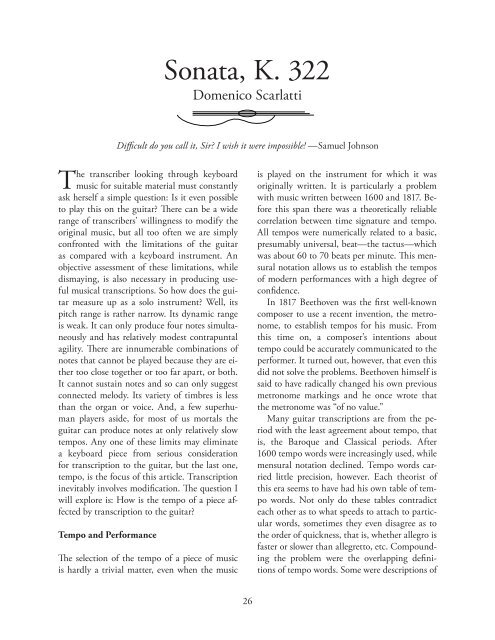


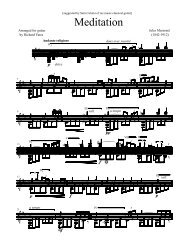
![Finale 2005b - [BWV846-Prelude in C.MUS]](https://img.yumpu.com/43978887/1/190x245/finale-2005b-bwv846-prelude-in-cmus.jpg?quality=85)
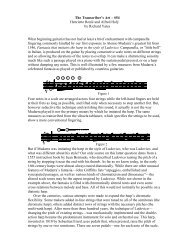
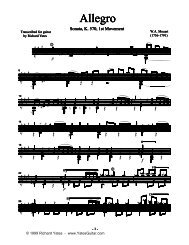

![Finale 2005b - [AirG-TAB.MUS] - Richard Yates Classical Guitar ...](https://img.yumpu.com/37104901/1/190x245/finale-2005b-airg-tabmus-richard-yates-classical-guitar-.jpg?quality=85)

